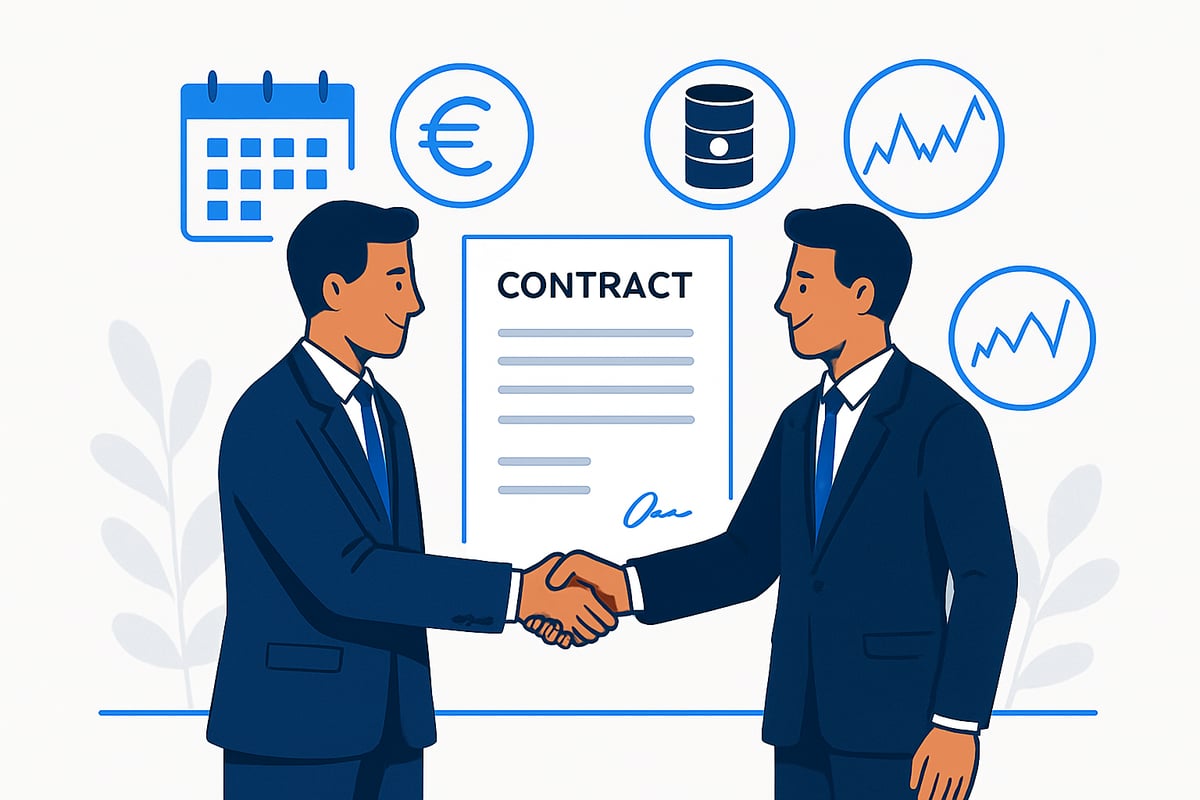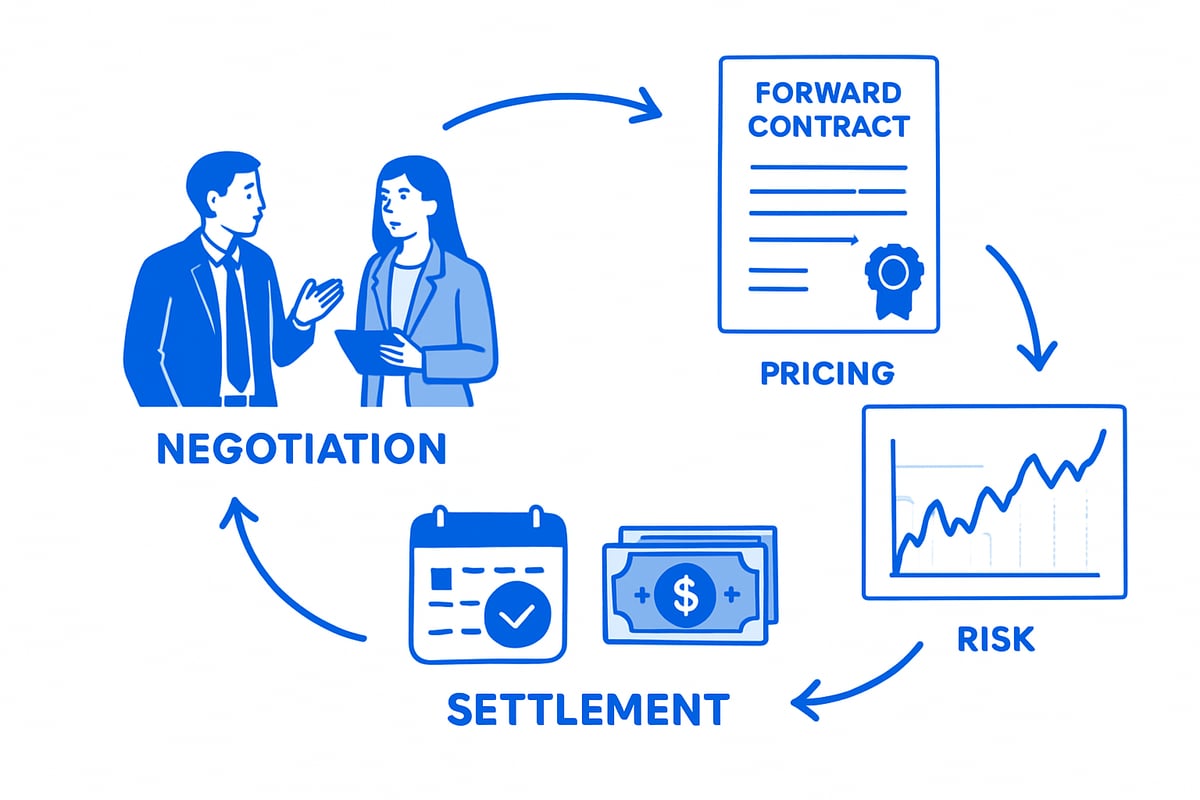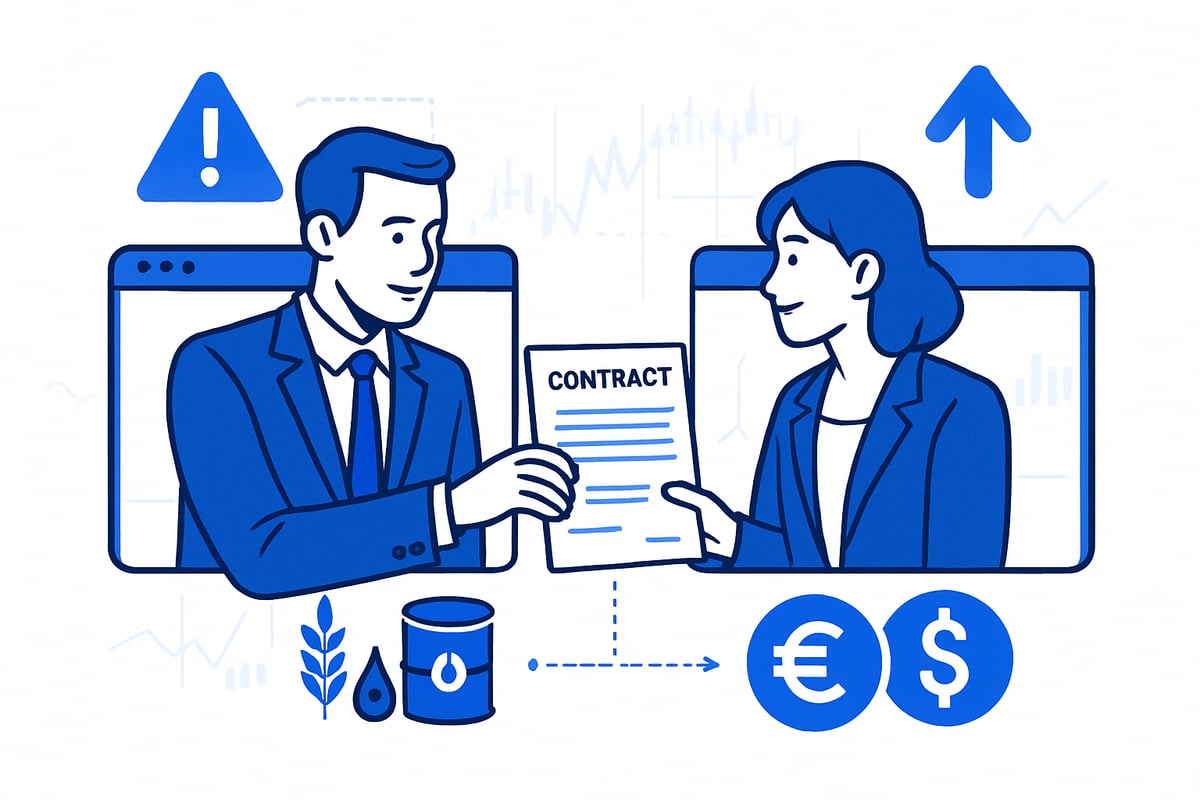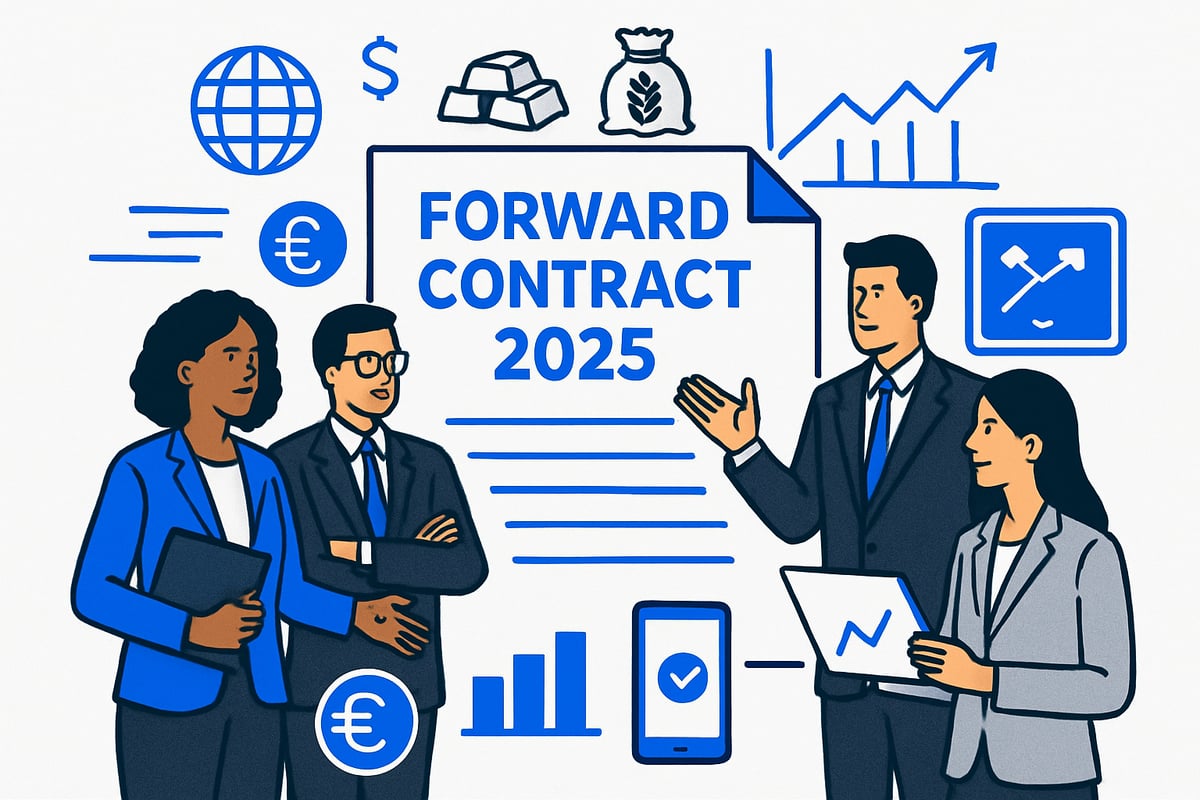Forward Contract Guide: Understanding Strategies for 2025
As global financial markets grow more unpredictable, risk management has never been more critical for businesses and investors. Navigating these shifting landscapes requires sharp tools and smart strategies.
A forward contract can be your key to stability in 2025. This guide breaks down what a forward contract is, how it works, and the best ways to use it for effective hedging and planning.
Inside, you’ll find practical tips, current trends, and step-by-step actions. Ready to master forward contracts for your financial future? Let’s get started.
What Is a Forward Contract?
Understanding a forward contract is essential for anyone navigating modern finance. These agreements are powerful tools for managing risk and locking in prices. As we move toward 2025, forward contracts are becoming even more relevant for businesses and investors facing unpredictable market shifts.

Definition and Core Concepts
A forward contract is a private agreement between two parties to buy or sell an asset at a specific price on a future date. Unlike standardized futures contracts, a forward contract is fully customizable, allowing both the buyer and seller to set their own terms. Common underlying assets include currencies, commodities, and even stocks.
These contracts are traded over-the-counter (OTC), not on an exchange, which means they are negotiated directly between parties. Settlement can involve physical delivery of the asset or a cash payment reflecting the price difference. Businesses often use a forward contract to hedge against price swings or plan for future purchases. For a deeper dive into these fundamentals, see Forward Contracts Explained 2025.
Key Features of Forward Contracts
A forward contract offers significant flexibility. The terms—such as amount, settlement date, and asset type—are tailored to the needs of both parties. Typically, no upfront payment is required, making it accessible for many businesses.
Negotiations happen directly, without the oversight of an exchange. This freedom comes with counterparty risk since there is no regulatory safety net. Forward contracts are also non-transferable, meaning only the original parties can settle or alter the deal.
Consider a farmer and a food processor: they might use a forward contract to lock in wheat prices months before harvest, reducing uncertainty for both sides.
Types of Forward Contracts
There are several types of forward contracts, each suited for different needs:
- Non-deliverable forwards (NDFs): Used in currency markets where physical delivery is restricted.
- Currency forwards: Lock in exchange rates for future transactions, helpful for importers and exporters.
- Commodity forwards: Secure prices for raw materials like oil or wheat.
- Equity forwards: Set future prices for stock purchases or sales.
- Interest rate forwards: Fix interest rates for loans or investments.
For example, an Indian exporter might use a currency forward to protect profits from exchange rate swings, while a manufacturer could use a commodity forward to stabilize costs.
Forward Contracts vs. Other Derivatives
Forward contracts differ from other derivatives in several key ways. Unlike futures, they are customized and traded OTC, leading to lower liquidity but greater flexibility. Options give the right, but not the obligation, to buy or sell, while swaps involve exchanging cash flows over time.
Here’s a quick comparison:
| Feature | Forward Contract | Futures | Options | Swaps |
|---|---|---|---|---|
| Customization | High | Low | Medium | High |
| Liquidity | Low | High | High | Medium |
| Exchange Traded | No | Yes | Yes | No |
| Counterparty Risk | High | Low | Low | Medium |
| Use Case | Hedging, Spec | Hedging, Spec | Hedging, Spec | Risk Mgmt |
Each derivative serves a unique purpose, but a forward contract stands out for its tailored approach, making it ideal for specific risk management strategies.
How Forward Contracts Work: Step-by-Step Process
Understanding the lifecycle of a forward contract helps investors and businesses use these tools effectively. Let’s break down the essential steps, from initiation to settlement, and highlight the risks you need to manage.

Initiating a Forward Contract
The journey of a forward contract begins with identifying a need, such as hedging against future price changes or speculating on market moves. Typically, a business or investor will approach a counterparty, like a bank or trading partner, to discuss the opportunity.
Both parties negotiate key terms. They agree on the asset, quantity, price, and settlement date. For example, an exporter expecting to receive euros in six months might use a forward contract to lock in the current exchange rate, protecting their revenue from currency swings.
This direct negotiation provides flexibility but also means each forward contract is unique and tailored to the specific situation.
Pricing and Valuation
Determining the value of a forward contract involves several factors. The agreed forward price is based on the asset's current spot price, adjusted for interest rates and any associated costs like storage or dividends.
A common formula is:
Forward Price = Spot Price × (1 + Risk-Free Rate × Time)
Other elements, such as supply and demand or market expectations, can influence pricing too. For currency forwards, understanding floating rate instruments is crucial, as interest differentials often impact the rate. For instance, if a U.S. company wants to fix a yen payment, the forward contract price reflects both USD and JPY interest rates.
Settlement and Maturity
When a forward contract reaches its maturity date, settlement occurs. There are two main methods: physical delivery, where the actual asset is exchanged, or cash settlement, where only the difference in value is paid.
Most forward contracts are settled without the involvement of a clearinghouse, so the original parties remain responsible for fulfilling the agreement. For example, a food processor with a wheat forward contract either receives the wheat or settles the price difference in cash, depending on the contract terms.
Careful coordination is essential to ensure both sides honor their obligations at maturity.
Risks and Counterparty Exposure
Entering a forward contract comes with inherent risks, especially counterparty risk—the chance that the other party defaults. Since these contracts are over the counter, there’s no exchange guaranteeing performance.
Mitigation strategies include performing credit checks, using collateral, or drafting strong legal agreements. Mark-to-market practices, where contracts are periodically revalued, can also help monitor exposure.
Imagine a scenario where a buyer defaults on a commodity forward contract. The seller may face losses if the market price has moved unfavorably. Clear documentation and risk assessments are critical to protect both parties.
Benefits and Risks of Using Forward Contracts
Understanding the benefits and risks of using a forward contract is essential for any organization navigating financial uncertainty. As businesses plan for 2025, weighing these pros and cons can help them make smarter, more resilient decisions.

Advantages of Forward Contracts
A forward contract offers several compelling advantages for businesses and investors looking to manage uncertainty.
- Hedging against price volatility: By locking in prices, companies can protect themselves from unpredictable market swings.
- Customization: Unlike standardized derivatives, a forward contract can be tailored to meet specific needs for amount, asset, and settlement date.
- No margin requirements: Unlike futures, forward contracts usually do not require upfront margin, improving cash flow.
- International trade support: They are widely used in global trade to stabilize costs and revenues, especially when dealing with fluctuating currencies.
For example, an airline might use a forward contract to hedge fuel costs, ensuring predictable expenses despite oil market changes.
Risks and Limitations
Despite their advantages, forward contracts carry notable risks that should not be overlooked.
- Counterparty credit risk: Since these are private agreements, there is a risk that one party may default on their obligation.
- Lack of liquidity: Forward contracts are not traded on an exchange, making it difficult to exit or transfer positions.
- Unfavorable locked-in prices: Market movements might make the agreed price less attractive.
- Regulatory and legal uncertainties: Shifting regulations and unclear enforceability can increase exposure to losses.
When evaluating risk, businesses often review metrics like the debt-to-equity ratio explained to determine the appropriate level of hedging with a forward contract.
Real-World Case Studies
Recent years have offered valuable lessons on forward contract use in practice.
- In 2023 and 2024, many Indian exporters relied on currency forward contracts to lock in exchange rates, protecting profits amid rupee volatility.
- Commodity producers, such as coffee growers, used forward contracts to manage sudden price swings, ensuring stable revenues.
- Some companies faced losses when counterparties defaulted or when market prices moved sharply against their contracted rates, highlighting the importance of thorough due diligence.
These examples show that while a forward contract can be a powerful tool, its success depends on careful implementation and risk assessment.
When Forward Contracts Are Most Effective
A forward contract is most effective in certain environments and for specific business profiles.
- High volatility markets: When prices are unpredictable, forward contracts provide much-needed certainty.
- Exporters and importers: Businesses exposed to currency or commodity price movements benefit greatly from hedging.
- Strategic timing: Initiating contracts when forecasts are uncertain can stabilize budgets and supply chains.
According to recent data, the use of forward contracts in global markets has grown steadily, especially among manufacturers and multinational corporations. This trend underscores their value as a strategic risk management tool.
Strategic Uses of Forward Contracts for 2025
Forward contract strategies are evolving rapidly as businesses prepare for 2025. Whether you are looking to hedge risk, speculate on market trends, or manage supply chains, understanding how to use a forward contract can provide a distinct advantage. Let’s explore how these contracts are being applied across different scenarios to boost financial resilience.

Hedging Strategies for Businesses
A forward contract is an essential tool for businesses aiming to shield themselves from unpredictable price swings in global markets. Exporters and importers frequently use these contracts to lock in exchange rates, ensuring stable revenues despite currency fluctuations.
Multinational corporations also rely on forward contracts to manage commodity price exposure, such as hedging fuel or raw material costs. For example, a technology firm sourcing semiconductors may enter into a forward contract to secure prices for upcoming production cycles.
Typical hedging strategies include:
- Fixing purchase prices for critical inputs
- Establishing predictable cash flows
- Minimizing the impact of adverse market moves
By adopting forward contract solutions, companies can achieve budget certainty and reduce the risk of financial surprises.
Speculation and Investment Applications
Besides hedging, a forward contract offers opportunities for investors and traders seeking to profit from market trends. Speculators use forward contracts to bet on anticipated shifts in asset prices, such as commodities, currencies, or equities.
Portfolio managers might include forward contracts to diversify holdings and balance overall risk. However, speculation with a forward contract carries significant risk, especially if market movements defy expectations.
For instance, an investor confident in rising gold prices for 2025 might enter a forward contract to buy gold at today’s price, hoping to sell at a higher value upon settlement. While the potential gains are attractive, losses can be equally substantial if prices fall.
Forward Contracts in Supply Chain Management
Supply chains benefit greatly from the stability a forward contract provides. Manufacturers often use these agreements to lock in costs for raw materials, helping protect against sudden price hikes that could disrupt budgeting or production schedules.
Take the example of a food processing company. By entering a forward contract to purchase grain at a set price, the company safeguards its margins and procurement plans. This approach makes it easier to forecast expenses and negotiate with downstream partners.
Key benefits for supply chain management include:
- Enhanced cost predictability
- Improved supplier relationships
- Greater operational resilience
Forward contracts thus play a vital role in long-term planning for manufacturers and distributors.
Forward Contracts in Emerging Markets
Businesses operating in emerging markets face unique challenges, such as volatile currencies and capital controls. Here, a forward contract becomes indispensable for managing financial risks and ensuring business continuity.
Non-deliverable forwards (NDFs) are especially popular in markets where physical settlement is restricted. Companies can hedge exposures without moving actual currency across borders, minimizing regulatory hurdles.
Recent data from 2023 and 2024 shows robust growth in forward contract usage in emerging economies, especially among exporters and multinational firms. These contracts offer a practical solution for navigating uncertain economic environments and protecting profit margins.
Adapting Strategies to 2025 Market Trends
As we approach 2025, forward contract strategies must evolve to match shifting market forces. Anticipated changes in global interest rates, inflation, and geopolitical tensions all impact contract pricing and risk management.
Businesses are increasingly integrating ESG factors into contract terms, such as using green commodity forwards. Geopolitical risk is now a top concern, and many companies are exploring hedging political risk with forward contracts to safeguard operations in unstable regions.
Adapting forward contract approaches ensures organizations remain agile, compliant, and well-positioned to capture emerging opportunities in 2025.
Regulatory and Accounting Considerations
The regulatory and accounting landscape for forward contract usage is also changing. Updates to international standards like IFRS 9 and ASC 815 require transparent reporting and robust documentation. Regulatory reforms in OTC derivatives demand higher compliance, especially around record-keeping and counterparty assessment.
Best practices for 2025 include:
- Maintaining comprehensive audit trails
- Regularly reviewing contract terms for compliance
- Training staff on evolving regulations
By focusing on regulatory and accounting requirements, organizations can maximize the benefits of a forward contract while minimizing legal and operational risks.
Key Trends and Innovations in Forward Contracts for 2025
As we approach 2025, forward contract markets are evolving rapidly. New technology, regulatory changes, sustainability goals, and advanced analytics are reshaping how businesses use these agreements. Staying updated with these trends is essential for anyone looking to gain an edge in risk management.
Digitalization and Technology Integration
Technology is transforming the way forward contract transactions are executed and managed. Electronic trading platforms are becoming the norm, allowing counterparties to negotiate and settle contracts swiftly and securely.
Blockchain technology is making forward contract settlement more transparent, reducing errors and building trust between parties. AI-driven pricing models and risk analysis tools now offer real-time insights, helping businesses make smarter decisions.
Fintech platforms even automate contract creation and monitoring. This digital shift not only speeds up processes but also cuts operational risks. As these tools become mainstream, expect forward contract management to be more accessible and efficient for companies of all sizes.
Evolving Regulatory Landscape
The regulatory environment for forward contract markets continues to shift. Since 2020, global reforms have aimed for greater transparency and stability. New rules require more detailed reporting, stronger compliance checks, and tighter oversight, especially for over-the-counter derivatives.
Regional differences remain important. For example, the US, EU, and Asia each have their own frameworks and compliance standards. Updates to regulations like EMIR and Dodd-Frank have impacted how institutions report and clear forward contract deals.
For a deeper look at these and other changes shaping the market, check out the Trends in Leveraged Derivatives Markets 2025. Adapting to regulatory shifts is crucial for maintaining compliance and reducing legal risks.
Sustainability and ESG-Linked Forward Contracts
Sustainability is now front and center in financial markets. Innovative forward contract structures are emerging that link terms to environmental, social, and governance (ESG) performance. Green forwards, for example, allow companies to lock in prices for renewable energy or carbon credits, supporting their sustainability targets.
Some forward contract terms may adjust based on ESG metrics, incentivizing greener operations. In 2024, several corporations piloted ESG-linked commodity forwards, aligning financial goals with responsible business practices.
This trend is set to grow in 2025, as investors and regulators demand more transparency and accountability. Companies using ESG-linked forward contract solutions can manage risk while enhancing their sustainability profile.
Market Data and Analytics for Forward Contracts
Access to real-time market data is critical for effective forward contract pricing and risk management. Modern analytics platforms provide instant updates on spot prices, interest rates, and volatility, helping businesses make informed decisions.
Data-driven tools now allow for detailed scenario analysis and stress testing of forward contract positions. The adoption of analytics is rising fast, especially in currency and commodity markets. For example, advanced dashboards can track exposure and performance at a glance.
Recent statistics show a surge in data-driven contract management, making it easier for organizations to monitor and optimize their forward contract strategies. Leveraging analytics is no longer optional—it is a competitive necessity.
Practical Steps to Implement Forward Contract Strategies
Navigating the implementation of a forward contract strategy in 2025 starts with clear, actionable steps. Each stage, from risk assessment to ongoing optimization, plays a vital role in ensuring your forward contract delivers the intended benefits. Let us break down the process into practical, manageable parts.
Assessing Organizational Needs and Risk Appetite
Begin by identifying your organization’s specific exposures, such as fluctuating commodity prices or volatile foreign exchange rates. Outline your strategic goals and clarify what you want your forward contract to achieve—hedging, budgeting, or profit stabilization.
Conduct a thorough risk assessment, evaluating how much uncertainty your business can tolerate. For example, a manufacturer exposed to unpredictable copper prices might run scenario analyses to gauge the impact of price swings. Align forward contract use with overall business objectives to ensure each contract addresses a real need.
Selecting Counterparties and Negotiating Terms
Choosing the right counterparty is essential for a successful forward contract. Evaluate financial stability, reputation, and past performance. Negotiate terms directly, covering price, quantity, settlement date, and asset specifics.
A negotiation checklist can help:
| Key Terms | Considerations |
|---|---|
| Price | Market rates, fair value |
| Quantity | Sufficient to hedge actual exposure |
| Settlement Date | Matches business cash flows |
| Documentation | Clear, enforceable, detailed |
Finalize all details in writing to prevent misunderstandings. This careful approach minimizes counterparty risk and ensures the contract suits your needs.
Pricing, Valuation, and Monitoring
Accurate pricing is at the heart of every forward contract. Use established models, factoring in spot price, interest rates, and any storage or carry costs. Tools and software can automate these calculations, improving reliability and transparency.
Once the forward contract is active, ongoing valuation is crucial. Mark-to-market practices help you track unrealized gains or losses as market conditions change. Regularly monitor both market data and your positions to stay ahead of unexpected shifts. For deeper insights on related strategies, see Top Futures Trading Strategies 2024-2025.
Documentation and Compliance
Drafting a legally binding forward contract is non-negotiable. Ensure all terms are clearly outlined, including asset type, settlement method, and contingency plans for disputes. Adhere to regulatory requirements such as KYC (Know Your Customer) and AML (Anti-Money Laundering) rules.
Keep thorough records for audit trails. A compliance checklist can help:
- Complete KYC and AML checks
- Verify contract details and signatures
- Store documents securely
- Maintain records for required periods
For definitions of key terms, consult the Financial terms glossary to ensure clarity across your documentation.
Managing Settlement and Post-Contract Obligations
As the settlement date approaches, prepare for either physical delivery or cash settlement, as specified in the forward contract. Communicate regularly with your counterparty to confirm arrangements and avoid last-minute surprises.
Should disputes or defaults arise, follow the agreed-upon procedures outlined in your contract. After settlement, conduct a post-mortem analysis. Review what went well and identify improvements for future contracts. Efficient handling of these stages safeguards your business from operational hiccups.
Best Practices for Forward Contract Success in 2025
Staying ahead in 2025 means continuous learning and adaptation. Invest in staff training to keep your team updated on forward contract trends and regulatory changes. Leverage technology for efficient management and risk tracking.
Regularly review your contracts and strategies, adapting to new market conditions or business objectives. Use this checklist for ongoing optimization:
- Update risk assessments quarterly
- Review contract performance metrics
- Integrate new analytics tools
- Attend industry webinars
Combining these best practices with robust education and reliable data will help you master the forward contract landscape and secure your organization’s financial future.
We’ve covered a lot about forward contracts—what they are, how they work, and the strategies you’ll need to stay ahead in 2025’s changing markets. If you’re ready to dive deeper and see how history shapes today’s financial decisions, you don’t have to do it alone. I invite you to be among the first to explore our interactive platform, where you can analyze market moves through real stories and powerful tools. Let’s uncover the patterns that matter and make smarter choices together.
Join as a Beta User
